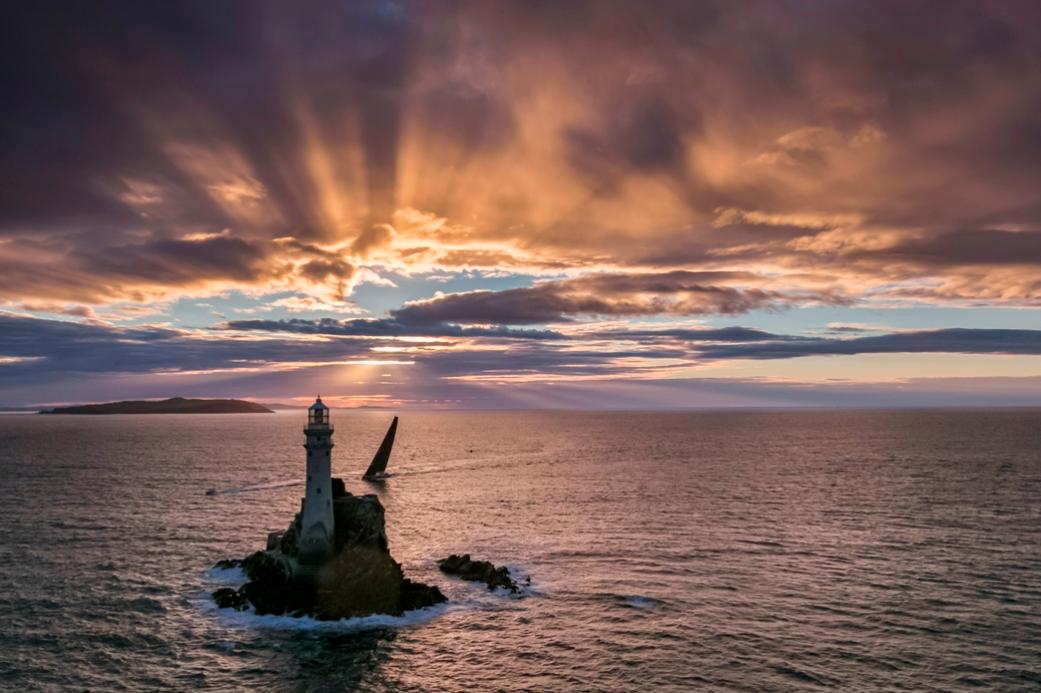August 13 - 19, 2017: Issue 325
PLYMOUTH REVISITED FOR OWNERS OF THE CLASSIC 1963 BUILT KIALOA II
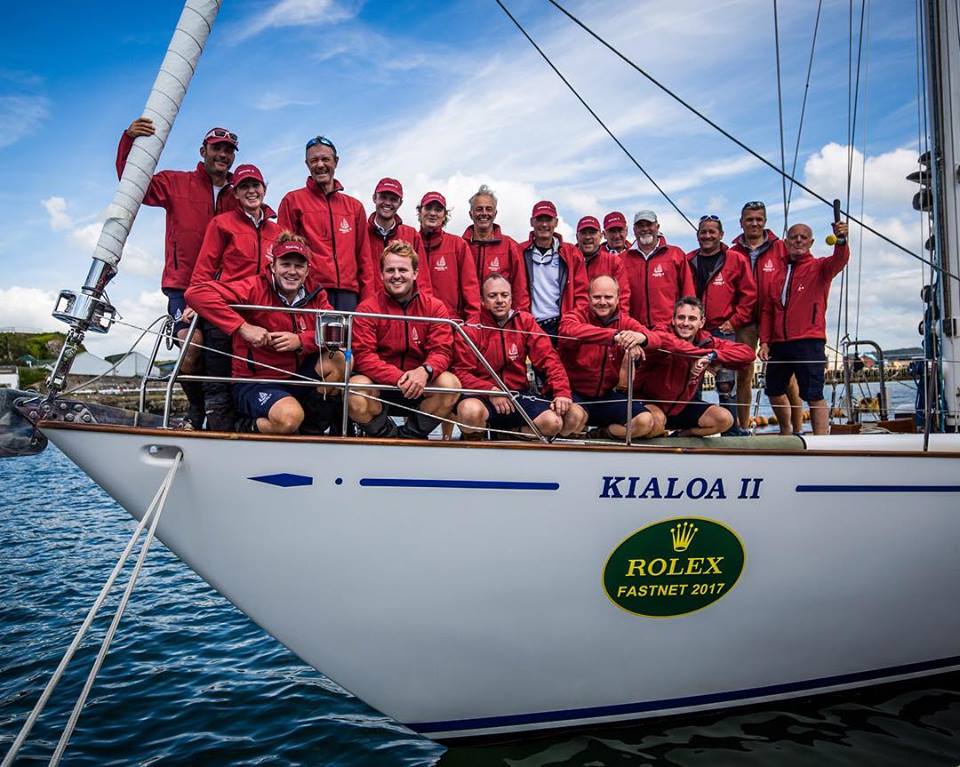
"Over the line at 12:39 today. Smiles everywhere!" - August 11, 2017 (2:02 AEST)
From Australia, Patrick and Keith Broughton's 72ft S&S Kialoa II and her crew © ELWJ Photography
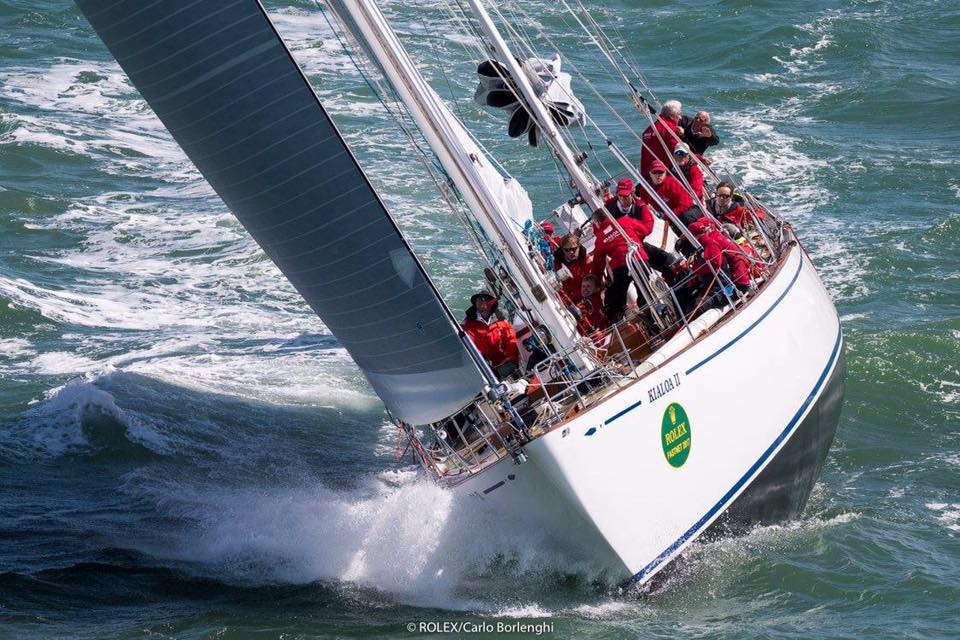
Kialoa II at start of 47th Fastnet race
PLYMOUTH REVISITED FOR OWNERS OF THE CLASSIC 1963 BUILT KIALOA II
August 11, 2017: AESDT - August 10th - UK Time
One of the most historic yachts racing in the 2017, the 47th Fastnet race, finished today in Jim Kilroy's Kialoa II, the 72ft S&S design that the famous American businessman campaigned to victory in the 1965 Transpac and the 1971 Sydney Hobart. The boat is now owned by brothers Patrick and Keith Broughton, who originally herald from Plymouth. However Patrick now lives in Sydney, at Elvina Bay, Pittwater, where he usually campaigns this classic racer. Having competed in the Rolex Sydney Hobart they sailed the boat from Sydney to take part in the Rolex Fastnet Race.
Brothers Patrick and Keith Broughton bought the iconic 73’ S&S yawl Kialoa II in 2016 with the view to competing in the classic ocean races such as the Rolex Fastnet Race, as she did under her original owner Jim Kilroy. As children, the brothers were at school in Plymouth and sailed the local waters. Since then they have raced many thousands of miles around the world and in Australia where Patrick is now resident.
“We’ve sailed half way round the world from here to Sydney since we’ve had the boat,” says Patrick. “Since then I have been looking forward to the Fastnet Race and rounding the Rock and coming back into Plymouth.”
He recounts “As far as rounding the Rock was concerned we were both lucky and unlucky. We were lucky because we ended up sailing around the Rock in daylight, but unlucky as we were hoping to be there a bit earlier, in the dark. The scene was spectacular with the moon still up.”
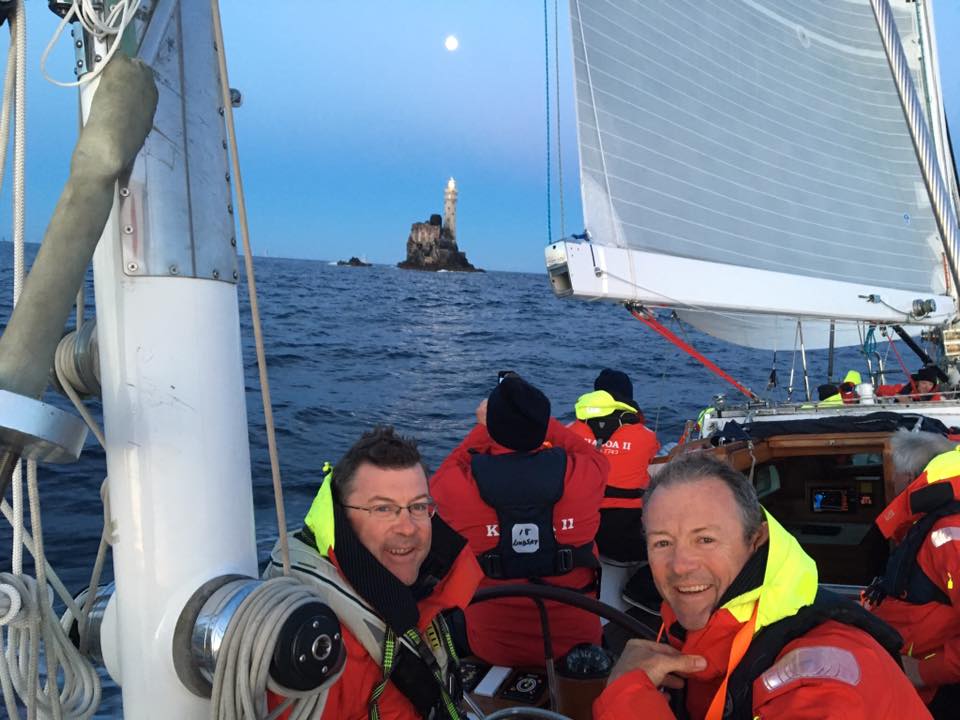
Brothers Keith & Paddy Broughton rounding Fastnet Rock. 6am 9 Aug. Photo courtesy Kialoa II crew
“We ran a little bit out of wind on the first evening. But actually as a whole the Fastnet experience was very good.”
The famous boat hasn't made too much of an impression on the results, but Broughton was nonetheless satisfied with their results.
"We were worried on the first day it would be really light as Kialoa weighs 45 tons, but we got into the swing of it and, when the breeze kicked in, things were better. The Solent was a bit scary short tacking among hundreds of boats. We don't like too many manoeuvres - we prefer straight lines..."
“As for coming into Plymouth,” he adds, “that was a bit more frustrating. It was a bit of a struggle as the breeze was fading out. But it’s good to be back here.”
“The whole race was very mixed for us. There was a lot of navigation to think about. “
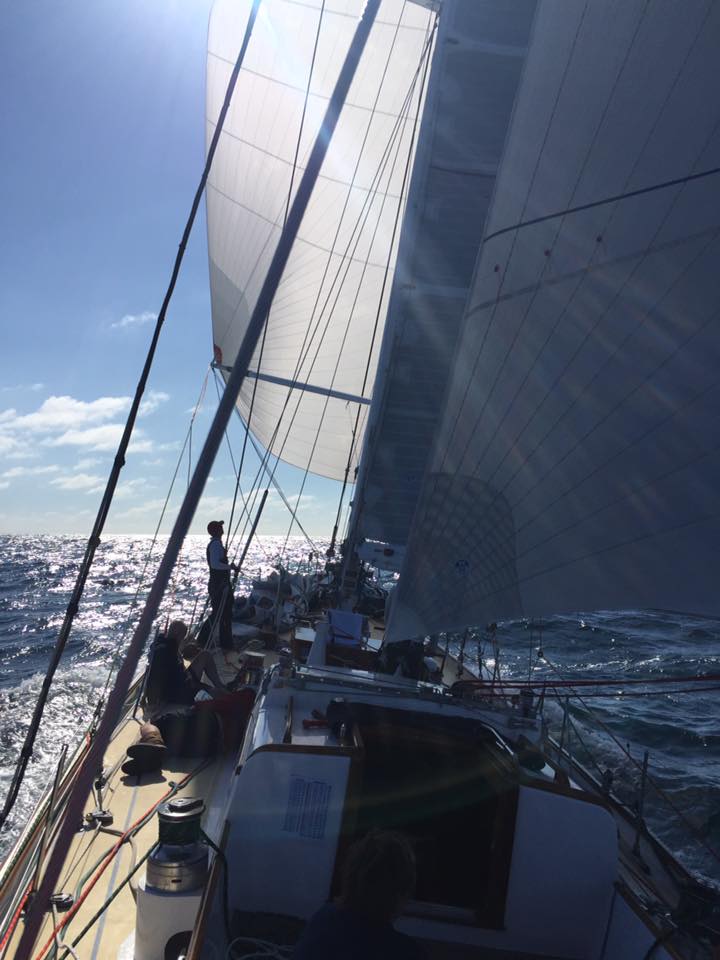
Making the most of the sail wardrobe: spinnaker, main, mizzen staysail and mizzen. August 10. Photo courtesy Kialoa II crew
There is a whole lot of history behind Kialoa II and some very skilled people on the boat. The experience stats for this crew are something to behold: a combined total of 162 Sydney to Hobart races of which seven crew are responsible for at least 10 apiece. They have a further 25 Fastnet races under their collective belts. Navigator Lindsay May has competed in 44 consecutive Sydney to Hobart races, while Alex Simpson has rowed the Atlantic, holding the record for a team of four of 35 days. Patrick himself has rowed for Cambridge University in the Oxford Cambridge Boat Race and for Great Britain and also rowed the length of the Mississippi (2,300 miles) in 2014.
Keith says “The crew all gel really well. We have a mixture of Australian and British nationals sailing on the boat. This is an old classic boat and there are a lot of things to re-learn. However the melding of the team is excellent. A lot of the British crew did the qualifier to allow the Aussies to come to take part, and we are deeply indebted to them to helping to allow us to put this campaign together.“
“After rounding the Rock we had a long run down to the Scillies and then it became effectively a fetch and we had some good trimming action.”
Kialoa II was built in 1963, and since has undergone a lot of modification and restoration. “We think she is still in her prime,” says Patrick, “although there are still some things to think about. The winches are a bit small for the boat by the standards of modern winches and we were really noticing that especially with so much tacking. But as far as performance is concerned she is still very exciting to sail. We had a fantastic charge down towards the Scillies with four sails up, a mizzen, a mizzen staysail and job and spinnaker up was a fantastic experience.” He adds “We could have done things the easy way on a modern boat but I guess we chose not to.”
As she finished the race Kialoa II was lying 144th overall in IRC and 37th in IRC One. “We are pretty satisfied with that,” agree the Broughton brothers. “We were worried on the first day that it would be really light racing, as Kialoa weighs 45 tons,” continued Patrick, “but when we got into the swing of it and the breeze kicked in things were better. We found another wind hole in the Scillies which didn’t help too much. We don’t like too many manoeuvres, we like straight lines!”
“The Solent was a bit scary short tacking amongst hundreds of boats. We have smaller boats in our class, and with the choppy waters at Hurst we knew we were going to be disadvantaged with the quick tackers around us. But being 45 tons we knew that if there were any incidents we would probably come off better!”
The boat’s original design goal was to compete and win in the maxi ocean racing category which it did fairly successfully, winning most of the major ocean races at least once during a racing career that spanned nearly a decade under Kilroy. One of her highlights was winning the gruelling upwind Sydney Hobart Race in 1971. She also won the 1965 Transpac Race (Los Angeles - Honolulu) in 9 days, 19 hours. From 1973 onwards Kialoa II has had a succession of owners including the United States Coast Guard Academy, all who have cared for her well and sailed her long distances in different parts of the world.
Finish Time Elapsed Handicap Corrected
10 Aug - 12:39:32 4 - 00:19:32 1.195 4 - 19:06:33
Article by Trish Jenkins, RORC- J2 Communications
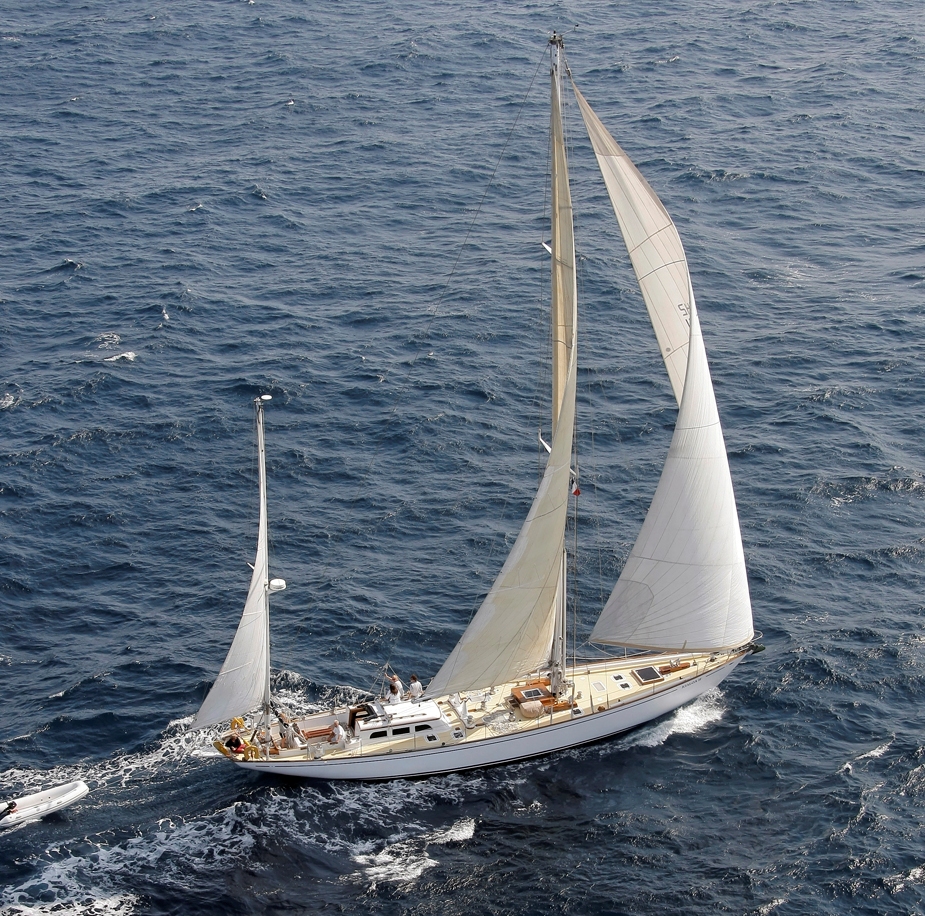
Kialoa II
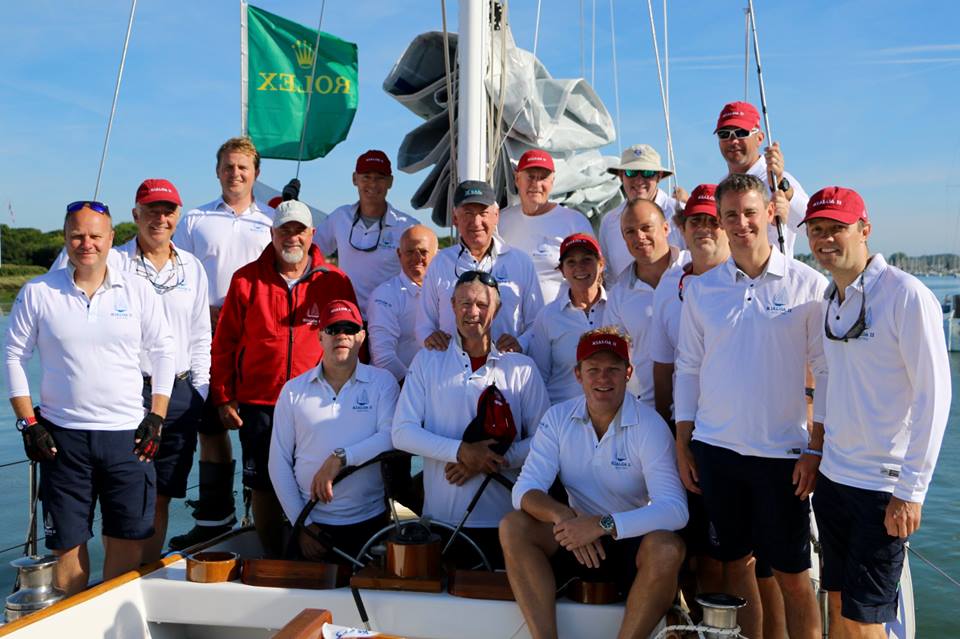
Kialoa II crew, Rolex Fastnet Race 2017.
Back: George Jackson, Jamie Hastie, Lindsay May, Andrew Cutler, Ian Goldsworthy.
Middle: Matthew Reed, Tony Hearder, David Sawdon, Jo Manser, Bob Bashem, Genevieve White, Rob Small, Grant Chessels, Sam Shrives, Tom Gresty
Front: Keith Broughton, Paddy Broughton, Matt Souter.
Classic Upwind Start For Record Breaking Rolex Fastnet Race
The Solent laid on 'classic' conditions for the start of the Royal Ocean Racing Club's 47th Rolex Fastnet Race. In brilliant sunshine and with brisk westerly winds gusting up to 20 knots, the giant fleet tacked up the western Solent before compressing through the usual bottleneck at Hurst Narrows. A record-sized fleet of 368 boats started the race, 12 more than two years ago, confirming the Rolex Fastnet Race's position as the world's largest offshore yacht race.
The first start got underway at 11:00 BST for the nine multihulls and within minutes, the blue three-hulled streak that is Concise 10 had pulled out a lead, frequently heeling to an alarming degree, just one hull immersed. By the time IRC One was starting at 12:20 Tony Lawson's MOD 70, skippered by Ned Collier Wakefield, was already off Poole. Crewman Paul Larsen, who five years ago became the world's fastest sailor setting a world record of 65.45 knots, reported Concise 10 was sailing under reefed mainsail and staysail. "We're making 20 knots tacking past Poole and just dropping into the watch system. Glamour start conditions in the Solent. I can just see the next boats clearing Hurst Castle." However Larsen warned that unless the wind freed up, there was little chance for them to break the multihull race record. By 1500 Concise 10 was already level with Portland Bill.
The multihulls were followed away from Cowes by two other 'non-IRC' classes - the nine doublehanded IMOCA 60s and twenty seven Class40s. Given the upwind conditions, the older, conventionally foiled IMOCA 60s were prevailing. At 1630 Paul Meilhat and Jules Verne Trophy record holder crewman Gwénolé Gahinet aboard SMA, the 2012-3 Vendee Globe (and the 2013 Rolex Fastnet Race) winner as MACIF, were leading the 60s past Portland Bill. The first 'foil-assisted' IMOCA 60 was favourite Alex Thomson and Nicholas O'Leary on Hugo Boss in third place, taking a northerly route, close to the land.
In the Class40s present championship leader Phil Sharp on board Imerys led past St Alban's Head, but later there was little too choose with the British boat neck and neck for the lead in this incredible fleet with the Maxime Sorel-skippered V And B, Burkhard Keese's Stella Nova, Benoit Charon's LMAX Normandie and race veteran Halvard Mabire and Miranda Merron on Campagne de France.
The five IRC handicap classes, chasing the race's overall prize of the Fastnet Challenge Cup started with the smallest boats first at 1120.
This afternoon at 1600, the IRC One fleet had fanned out across the course to the southeast of St Alban's Head. James Neville's HH42 Ino XXX was leading the charge inshore as Staffan Wincrantz's Arcona 465 SALT 2.0 was ahead on the water to the south, just ahead of the venerable 1960s maxi Kialoa II, owned by Patrick Broughton.
Mid-afternoon, competitors in IRC Two were favouring the inshore route with Dutchman Frans Rodenburg's First 40 Elke, closest to St Alban's Head at 1620, with class favourite Gilles Fournier and Corinne Migraine's J/133 Pintia nearby.
The IRC Three boats were following a similar tactic with the offshore tack being less popular. Having started 20 minutes earlier, they were still successfully fending off the advances of the larger, faster IRC Two fleet. The Russian JPK 10.80, Igor Rytov's Boyatyr, was leading the pack inshore while the brilliantly-named Seafarers Ale Anticipation, the First 40.7 of former 470 Olympian Pete Newlands, was ahead on the water offshore.
The inshore-offshore spread was more evenly distributed among the smallest boats in IRC Four. Here Noel Racine's impeccably sailed JPK 10.10 Foggy Dew was ahead inshore while Dan Rigden's Elan 37 Tacktic was furthest down the track out to sea.
The last to start were the largest in the IRC fleet, IRC Zero, including the line honours contenders George David's Rambler 88 and Ludde Ingvall's 100ft CQS. By 1520 Rambler 88 was off and close into St Alban's Head, leading IRC Zero on the water just ahead of the biggest boat in the fleet, the 115ft Nikata.
Among the seven one design VO65s competing in 'Leg 0' of the 2017-18 Volvo Ocean Race, it was very close, with the Charles Caudrelier-skippered Dongfeng Race Team a nose ahead and making 12.3 knots but facing a threat from Team Brunel, skippered again by Dutch race veteran Bouwe Bekking, making 12.5 as the boats passed St Alban's Head.
This morning Xabi Fernández, skipper of MAPFRE, looked forward to the race: "Once out of the Solent it will be upwind sailing up to the Fastnet rock, and finally we will sail downwind towards Plymouth. This is the first time I've competed in the Rolex Fastnet Race. It is a historic race, much like the Rolex Sydney Hobart."
Joan Vila, MAPFRE's legendary navigator confirmed the forecast: "Once we leave the Solent, the wind will blow at around 20 knots. From there, it will drop until tomorrow morning, with the probability of encountering areas of very light wind. As we get closer to Plymouth, the wind will build again."
Report by James Boyd, RORC- J2 Cmmunications
ROLEX FASTNET RACE: PERSEVERANCE PAYS
ROLEX FASTNET RACE
August 6 - 11, 2017
Press Release: Plymouth, 9 August 2017.
In his four attempts at the race, American George David has witnessed first-hand the Rolex Fastnet Race’s compelling, complex and capricious nature. Monohull line honours victory for his 88-ft Maxi yacht in 2017 follows three contrasting races over the past decade. Twice David’s Rambler has finished second on the water and in between a race which ended dramatically in the Celtic Sea.
“It was a good race,” reflected David dockside in Plymouth on Tuesday evening immediately after completing the 47th edition of the race, one which took his crew 2 days, 9 hours, 34 minutes and 21 seconds to negotiate. Monohull line honours was rarely in doubt. Rambler 88 led her rivals throughout the 605-nm race from Cowes and her nearest competitor, the 100-ft Australian Maxi CQS, crossed the finish line nearly five hours later. “We’ve had two windy races, one with no wind two years ago, and this one with decent wind, a tough windward-leeward course. 360-nm upwind is a challenge especially in the cold.”
David’s first Rolex Fastnet Race in 2007 on the 90-ft Rambler was defined by an epic contest with Mike Slade’s 100-ft Maxi ICAP Leopard. The two yachts provided a spectacle of raw intensity as they duelled around the Fastnet Rock before Slade’s British yacht eventually claimed victory by a little over an hour. Second on the water, David also finished runner-up on IRC handicap to eventual winner Chieftain, a Cookson 50 from Ireland.
With a clear ambition, David returned four years later with a new 100-ft Rambler. The race started positively. Leading the monohull fleet in record-breaking conditions and having rounded the Fastnet rock, Rambler 100’s keel snapped off. David and four crew members ended up in the water, while the remainder of crew found safety on the upturned hull. Thanks to the presence of a photo boat and the efforts of the Irish coastal services all were rescued safely.
Understandably, David has built an affinity with the people who came to their rescue, contacting them during the 2017 race. “We called the Valentia MSRC, the search and rescue unit for Ireland, and had a talk to them on the radio and the Baltimore RNLI. We know those people very well having met them in the direst of circumstances. They are wonderful people and it was nice to connect with them.”
Returning to the race in 2015 with his current 88-ft Rambler, David this time found competition from a rival American yacht, Jim Clark’s 100-ft Maxi Comanche. The finish was a close affair. Unable to overhaul Comanche on the arduous final passage into Plymouth, Rambler 88eventually finished four minutes off the pace.
Of the 21 people involved in the 2011 race, six featured as part of the Rambler 88 crew in 2017, helping fulfil David’s decade-long ambition to be the fastest monohull at the Rolex Fastnet Race. David closes: “We have wanted line honours since 2007 and have been bridesmaids the first three times. I thought we had a good chance at the start of the race and this time we did it.”
Neither Rambler nor Concise 10, confirmed as the fastest mutilhull yacht in the early hours of Tuesday morning, were able to break the current race records, both set in 2011.
The focus now turns to the progress of the remainder of the record-breaking 362-strong fleet. At 13:00 BST, 28 yachts had arrived in Plymouth and there had been 22 retirements. Currently leading in the race on IRC handicap is the Cookson 50 Privateer, owned by Ron O’Hanley. She is hoping to become the first American entry to win the Rolex Fastnet Race since 1989. Tim Dawson, the boat’s tactician, was one of the sailors on Rambler 100 rescued in 2011, and is sailing his third Rolex Fastnet: “We had very favourable currents and conditions. For us it was about managing our plan versus the similar speed boats around us. To use a basketball term we stayed between them and the hoop.”
With most of the fleet having now rounded the Fastnet Rock and on the return leg to Plymouth, how the weather develops over the next 24 hours will play a decisive role in determining the eventual overall winner of the 2017 Rolex Fastnet Race.
Elsewhere, Dongfeng Racing Team from China was the fastest Volvo 65 to Plymouth arriving on Wednesday morning at 04:18 BST and defeating the Spanish entry Mapfre by a mere 54 seconds. In the IMOCA 60 fleet, French sailors Gwénolé Gahinet and Paul Meilhat sailing SMA held off the opposition to win their class. In the Class 40, V and B holds a small lead over Imerys, with both expected to finish this afternoon.
Follow the Rolex Fastnet Race fleet at www.rolexfastnetrace.com
A NATURAL AND SUPPORTIVE PARTNER
Rolex has always sought to associate with activities that, like itself, are motivated by passion, excellence, precision and team spirit. Naturally, Rolex gravitated toward the elite world of sailing, forming an alliance that dates back to the late 1950s. Today, Rolex is Title Sponsor of some 15 major international events. From leading offshore races, such as the Rolex Sydney Hobart and the biennial Rolex Fastnet Race, through to the highest-level grand-prix competition at the Rolex TP52 World Championship, spectacular gatherings at the Maxi Yacht Rolex Cup and the Rolex Swan Cup, as well as its close relationships with the most prestigious yacht clubs around the world such as the New York Yacht Club (US), the Yacht Club Costa Smeralda (Italy) and the two clubs at the very heart of the Rolex Fastnet Race, Rolex has established an enduring relationship with pinnacle of yachting.
Race organizer the Royal Ocean Racing Club (London/Cowes, UK), was founded in 1925 immediately after the conclusion of the first Fastnet Race. The club has long been a pioneer and innovator, not only organizing and promoting offshore racing activities, but also in developing standards of excellence, particularly in issues of safety. The Royal Yacht Squadron (Cowes, UK), an exclusive and active club, celebrated its bicentenary in 2015 and has enjoyed a close partnership with Rolex since 1983. In recognition of its privileged relationship, and to mark the 200-year anniversary, Rolex presented the Squadron with a unique clock that does more than simply tell the time – it gives details about the state of the tide and barometric pressure: essential information for race officers and sailors alike.
ABOUT ROLEX
Rolex, the Swiss watch brand headquartered in Geneva, enjoys an unrivalled reputation for quality and expertise the world over. Its Oyster and Cellini watches, all certified as Superlative Chronometers for their precision, performance and reliability, are symbols of excellence, elegance and prestige. Founded by Hans Wilsdorf in 1905, the brand pioneered the development of the wristwatch and is at the origin of numerous major watchmaking innovations, such as the Oyster, the first waterproof wristwatch, launched in 1926, and the Perpetual rotor self-winding mechanism invented in 1931. Rolex has registered over 400 patents in the course of its history. A truly integrated and independent manufacturing company, Rolex designs, develops and produces in-house all the essential components of its watches, from the casting of the gold alloys to the machining, crafting, assembly and finishing of the movement, case, dial and bracelet. Rolex is also actively involved in supporting the arts, sports, exploration, the spirit of enterprise, and the environment through a broad palette of sponsoring activities, as well as philanthropic programmes.
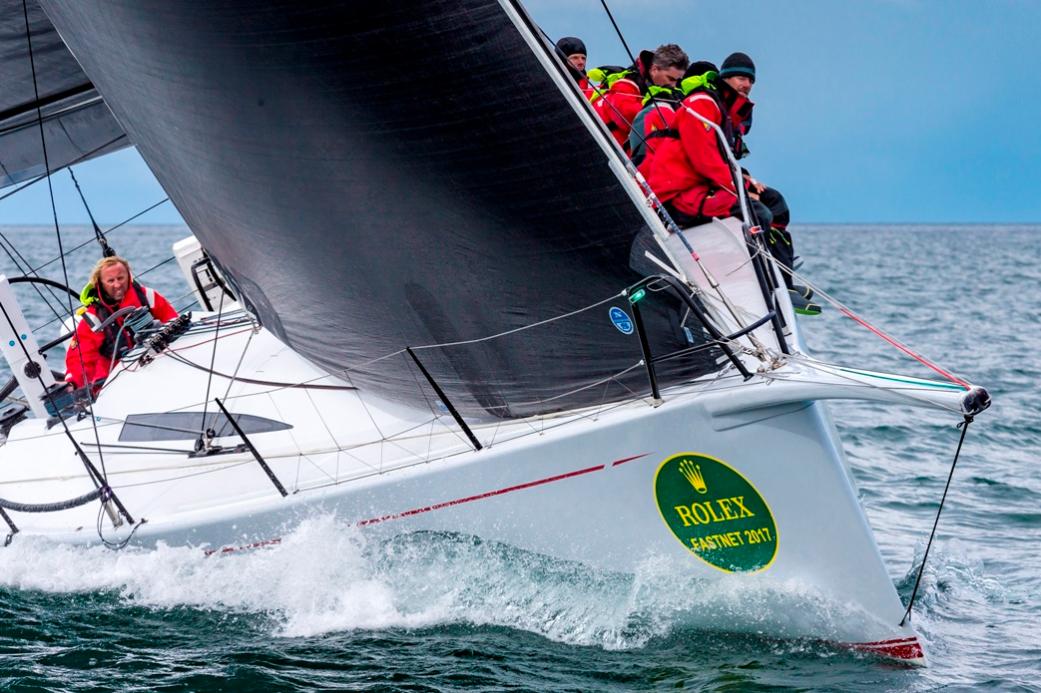
George David's Rambler
France Claims Fastnet Challenge Cup For Third Consecutive Time
August 11, 2017
For a third time running the Rolex Fastnet Race has been a story of French domination, Le Tricolor flying on this occasion from the top spot in IRC 1, 2, 3 and 4, the Class40 and IMOCA 60, the Two Handed and IRC Overall. Even the Chinese boat, Dongfeng Race Team, that won Volvo 65 competition had a largely French crew. This left IRC Zero to American Ron O'Hanley's Cookson 50 Privateer, while, surprisingly, the only British class victory went to Tony Lawson's MOD 70 trimaran Concise 10, in the usually French-strong Multihull class.
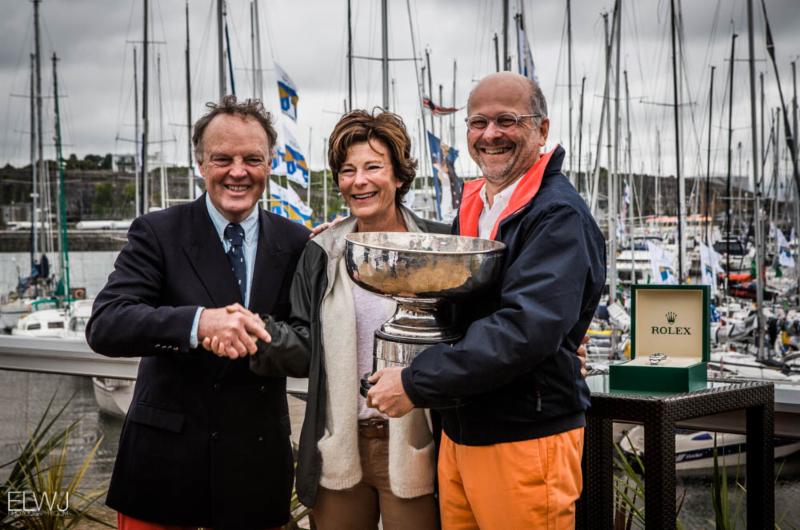
RORC Commodore, Michael Boyd presents the Fastnet Challenge Cup to the overall winner, Didier Gaudoux's JND39, Lann Ael 2 © ELWJ Photography/RORC
Early on, the overall prize looked set to be a big boat affair with both the JV 115 Nikata and George David's maxi Rambler 88 leading until the run back from the Fastnet Rock favoured the medium-sized boats.
Ron O'Hanley's Privateer came close to making it a second Cookson 50 victory, a decade on from the overall win of Irishman Ger O'Rourke's Chieftain.
"This is a great race, an iconic race and we have had a great time even if we haven't won," said O'Hanley. "It was a fantastic start in Cowes - hard to see how you can get 400 boats out of the Solent at the same time! The weather conditions were good, not as light as it was last time and there was no drama coming out of the Solent."
As to where they did well, it was on the run back from the Rock said O'Hanley. "The big boats were leading, but then for a smaller boat to get into the lead was because of the very good conditions - tight reaching, we were planing most of the time and with the canting keel we could put a lot of miles on the clock."
However by Wednesday it became apparent that there was a new contender for the 2017 Fastnet Challenge Cup - the overall prize under IRC.
Didier Gaudoux's JND39, Lann Ael 2, struggled last year when she competed in the Brewin Dolphin Commodores' Cup, however then she was only six months old. Since then the team, based out of La Crouesty in southern Brittany has tweaked the boat considerably with the assistance of sailmaker and former Mini and Figaro sailor Fred Duthil.
"We had a fantastic race. We were lucky with the weather. The conditions were good for the team and the crew," said Gaudoux. "From Fastnet Rock to the Scilly Isles was perfect for us - the wind angle, the size of the waves, etc. It was windy and these boats enjoy big waves. We were doing over 20 knots- a new record for us!"
Prior to this, the French boat had benefitted by going so close in at the Lizard that "we could touch the rocks," said Gaudoux. Like the other boats that did well, Lann Ael 2 went east of the traffic separation scheme off Land's End, benefitting them greatly in terms of the distance to sail and favourable wind shifts. "Our navigator/tactician did a perfect job to tack on the right shifts," said Gaudoux.
The JND 39 is a heavily-chined design from Bernard Nivelt and ate up the miles on the run towards Bishop Rock. "It took 11 hours to cover 170 miles! We were surprised. We were two to three miles ahead of some good competitors at the Rock and by the Scilly Isles we were 30 miles ahead simply because we were going faster," said Gaudoux.
Paris-based Gaudoux was sailing with his son Thomas and daughter Coralie, navigator Fred Duthil, plus Nicolas Deberque, Nicolas Dore, Alois Kerduel, Pierre Louiset, Paulin Nicol and Christian Ponthieu.
As to the Rolex Fastnet Race, this is Gaudoux's fourth: "When I was 16 years old, the Fastnet was a dream. The RORC lays on very nice races. Although it is a long way to come, boats take part from all around the world. We receive a nice welcome and the races are always very well organised."
With the prizegiving for the Rolex Fastnet Race taking place tonight, boats continue to stream into Plymouth. Among them has been the Frers 46, Scaramouche, crewed by Greig City Academy in East London including eight students aged 15 and 18, plus two teachers, two skippers and a team manager.
The boys are almost all first generation Londoners, and embraced the unfamiliar challenge of ocean racing with huge enthusiasm. "It was a real test for them," said team manager John Holt. "They are true pioneers amongst their peer group."
17 year old Montel Fagan Jordan, whose family comes from Jamaica, was a helmsman on board. "I started sailing in dinghies three years ago, but now it's great to be on a big boat. We had some great surfing downwind after we got round the Fastnet Rock."
Bowman Camillo Oribo, also 17, agreed: "The way back was definitely the best bit. We flew with the spinnaker up. We don't get too tired once we've established a watch system."
PROVISIONAL RESULTS:
IRC Z: 1. Privateer - Cookson 50, Ron O'Hanley (USA); 2. Lady Mariposa - Ker 46, Daniel Hardy (GBR); 3. Bretagne Telecom - Mach 45, Nicolas Groleau (FRA)
IRC 1: 1. Lann Ael 2 - JND 39, Didier Gaudoux (FRA); 2. Pata Negra - Lombard 46, Hermann de Graaf (NED); 3. Ino XXX - HH42, James Neville (GBR)
IRC 2: 1. Pintia - J/133, Gilles Fournier / Corinne Migraine (FRA); 2. Lisa - First 44.7, Michael Boyd (IRE); 3. Elke - First 40, Frans and Carla Rodenburg (NED)
IRC 3: 1. Dream Pearls - JPK 10.80, Arnaud Delamare and Eric Mordret (FRA); 2. Timeline - JPK 10.80, Marc Alperovitch (FRA); 3. Bellino - Sun Fast 3600, Rob Craigie (GBR)
IRC 4: 1. Night and Day - JPK 10.10, Pascal & Alexis Loison (FRA); 2. Foggy Dew - JPK 10.10 (FRA), Noel Racine; 3. Cocody - JPK 10.10, Richard Fromentin (FRA)
IRC Two-Handed: 1. Night and Day - JPK 10.10, Pascal Loison (FRA); 2. Ajeto! - J/122e, Robin Verhoef and John van der Starre (NED); 3. Bellino - Sun Fast 3600, Rob Craigie and Deb Fish (GBR)
VO65: 1. Dongfeng Race Team (CHN) - Charles Caudrelier; 2. MAPFRE (ESP) - Xabi Fernandez; 3. Team Brunel (NED) - Bouwe Bekking
IMOCA 60: 1. SMA - Paul Meilhat/Gwenole Gahinet (FRA); 2. StMichel-Virbac - Jean-Pierre Dick/ /Yann Eliès (FRA); 3. Malizia - Yacht Club de Monaco - Boris Herrmann/Pierre Casiraghi (MON)
Class40: 1. V and B - Maxime Sorel (FRA); 2. Imerys - Phil Sharp (GBR); 3. Campagne de France - Halvard Mabire (FRA) and Miranda Merron (GBR)
MOCRA Multihulls: 1. Concise 10 - MOD 70 trimaran, Tony Lawson (GBR); 2. R-six - HH66 catamaran, Robert Szustkowski (POL); 3. Hissy Fit - Dazcat 1495, Simon Baker (GBR)
Royal Ocean Racing Club:
Established in 1925, The Royal Ocean Racing Club (RORC) became famous for the biennial Fastnet Race and the international team event, the Admiral's Cup. It organises an annual series of domestic offshore races from its base in Cowes as well as inshore regattas including the RORC Easter Challenge and IRC National Championship in the Solent.
The RORC works with other yacht clubs to promote their offshore races and provides marketing and organisational support. The RORC Caribbean 600, based in Antigua and the first offshore race in the Caribbean, has been an instant success. The 10th edition will take place in 2018. The RORC extended its organisational expertise by creating the RORC Transatlantic Race from Lanzarote to Grenada, the first of which was in November 2014. This year, the RORC Transatlantic Race will finish at Virgin Gorda, BVI as part of the Atlantic Anniversary Regatta
The club is based in St James' Place, London, but after a merger with The Royal Corinthian Yacht Club in Cowes, now boasts a superb clubhouse facility at the entrance to Cowes Harbour and a membership of over 4000
RORC website: www.rorc.org
Race minisite: http://www.fastnet.rorc.org
Report by James Boyd, RORC J2 Communications
